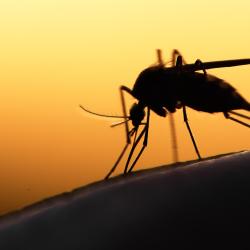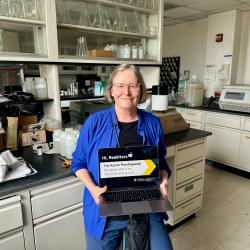From Ocean Dynamics to the State of the Climate
NOAA oceanographer Tim Boyer (Ph.D. ’24, atmospheric and oceanic science) tracks changes in the subsurface ocean that play an important role in Earth’s climate system.
For Tim Boyer (Ph.D. ’24, atmospheric and oceanic science), an impactful 30-year career as an oceanographer for the National Oceanic and Atmospheric Administration (NOAA) was inspired by a powerful first impression.
“I do not remember if it was the first time I saw the ocean, probably not, but I remember the first time I bodysurfed in the ocean,” Boyer recalled. “I was hurtled toward the shore at terrifying velocity and slammed headfirst pretty violently into the sand before being pulled back out toward open water. So began my fascination with, and fear of, the power and vastness of the ocean.”

Today, Boyer is one of the longest-serving oceanographers at NOAA’s National Centers for Environmental Information (NCEI) and leads its Ocean Climate Laboratory team, gathering and analyzing mountains of data on changes in the subsurface ocean that play an important role in our changing global climate.
“90% of the Earth’s energy imbalance goes into the ocean, so if you’re able to measure change in the ocean
Since 2021, thanks to his expertise in ocean dynamics, Boyer has served as co-editor for one of the most comprehensive annual report
“The State of the Climate, it’s a catalog of where we are, and where we are relative to the years before. And for 2023 especially, some of the headlines were pretty concerning—global mean surface temperature increased by 0.15 degrees Celsius, which is an extraordinary amount. The State of the Climate looks not only at the global scale, but regionally and even locally. A particularly stark indicator: In October 2023, the level of the Rio Negro, which feeds the Amazon at Manaus, Brazil, reached its lowest level since 1903,” Boyer noted. “I hope that these reports can be a signal that we need to, if not address the causes, at least adapt in some way.”
Drawn to the water
Raised in Wisconsin, Boyer grew up with a strong interest in science and an appreciation for nature and the outdoors. Whether it was visiting relatives on the Jersey Shore, where he had his first memorable experiences with the ocean, or exploring lakes and rivers closer to home, Boyer was always close to the water.
“Growing up, I spent a fair amount of time bodysurfing, and I experienced a lot of joy riding those waves,” Boyer said. “I loved being in the outdoors, camping in the woods, swimming in Lake Michigan and fishing on the Fox River.”
Fascinated by the mysteries of the world around him, Boyer earned his undergraduate degree in physics and mathematics in 1989 close to home at St. Norbert College in Wisconsin and then set his sights on the Atlantic coast—and graduate school—where he earned his master’s degree in physical oceanography at Old Dominion University in Norfolk, Virginia.
“I got a good background there in the different disciplines in oceanography—biological, chemical, geological and of course physical, which was my major,” Boyer said. “I started to work on large-scale ocean circulation and ocean changes, studying ocean dynamics. Applying physics and math to an environmental pursuit and being out on the ocean to make the observations, which would inform the equations has always had great appeal to me.”
In 1991, immediately after earning his master’s degree, Boyer joined NOAA, working closely with a scientist named Sydney Levitus, who pioneered strategies for tracking the changes occurring in the subsurface ocean. Though Boyer envisioned a research life at sea, gathering oceanic data at the source, the reality was very different.
“My idea of going to school for oceanography was being out on the ocean on research ships and taking the measurements. But for physical oceanography, in my early work with NOAA and much more so now, there’s little need to go out to do your research. Most of the data comes from automated ocean probes—instruments in the ocean—which send their information to satellites and then back to us,” Boyer explained. “For the most part, my work’s been on computers, gathering the data, both historic and recent, trying to understand long term, what does the ocean even look like—the temperature structure or salinity structure, and how has the ocean been changing over time.”
In his first 20 years at NOAA, Boyer wrote or contributed to dozens of studies and reports on ocean temperature, salinity, oxygen levels and more. By 2006 when he joined a working group with James Carton, a professor in the University of Maryland’s Department of Atmospheric and Oceanic Science, Boyer’s ocean studies were making a significant impact.
“Syd Levitus and the Ocean Climate Laboratory energized the whole data collection and analysis part of NOAA, and Tim is carrying on that work, ” Carton explained. “This is crucial because NOAA is the United States’ operational weather and climate agency, and it just turned out that these kinds of measurements are more and more relevant particularly because of the global warming issue.”
A new challenge
As Carton got to know Boyer better, he encouraged him to add one more challenge to his long list of NOAA responsibilities.
“Jim saw that I only had a master’s degree,” Boyer said, “and he asked me if I wanted to come to the University of Maryland and work with him towards a Ph.D. and do some collaborative work.”
“I’ve had a lot of graduate students, but Tim was different,” Carton explained. “He’s someone who’s been in the field for some time, has a job with high responsibility and plays a key role in the United States’ ability to track the Earth’s climate system, so I thought it was really important for Tim to go back and get his Ph.D. so he can fully realize his potential and his unique position within NOAA.”
Boyer accepted the challenge in 2012. Over the next several years, his Ph.D. research quantifying Earth’s energy imbalance through ocean heat content and classes that gave him a greater understanding of the physics and dynamics of the atmosphere helped him connect the dots between the ocean and the entire climate system. That, in turn, enhanced Boyer’s work as a NOAA oceanographer and co-editor of the State of the Climate report, which compiles the work of scientists from around the world—including many from UMD—to tell each year’s climate story.
“The work I did at the University of Maryland, what I learned really helped me to understand the big picture, so I could edit any section of the State of the Climate—atmospheric, land or ocean—and see how it all fit together,” Boyer said. “Anything from precipitation to wildfires to El Niño, all of these things are linked to the ocean but have repercussions for the overall climate system and what we experience as humans.”
In August 2024, the same month the State of the Climate report came out, Boyer earned his Ph.D. from UMD. But he says his work tracking changes in the ocean and the impact on our global climate system is just beginning.
“My fascination and fear for the power of the ocean has only grown with time,” Boyer explained. “We understand that the ocean is a key component of the Earth's climate system, absorbing heat and carbon, fueling hurricanes, etc.—and any place you can think of, even the most natural place that might seem unaffected by







